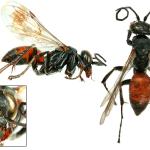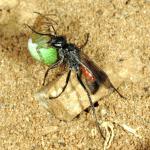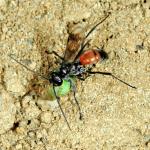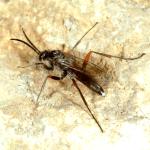Largely confined to southern and eastern England, with records from coastal counties from Cornwall to Essex, and inland northwards to Somerset, Wiltshire, Buckinghamshire and Cambridgeshire. Records outside the main range are from Glamorgan, Lincolnshire and North-east Yorkshire. There are no records from the Channel Islands or Ireland.
The wasp has a Holarctic distribution (Day, 1988).
This species is not regarded as being scarce or threatened.
Frequents exposures of dry, sandy or sandy-clay soils (Day, 1988). Males are rarely found by direct searching, but may be frequent in Malaise-trap catches (M Edwards, pers. comm.)
June to early October (Day, 1988), with a peak in late July and August (S P M Roberts, pers. comm., based on a dataset of 36 records).
Prey consists of orb-web spiders of the genus Meta (Tetragnathidae) and Araneus (Araneidae) (Day, 1988).
Short, vertical burrows are excavated in sandy soil after the prey has been caught. The prey item is gripped in the jaws, between the thorax and abdomen, and carried in front of the wasp. The prey is interred in a vertical position in the cell (Day, 1988).
No information available.
2001





